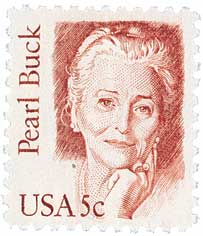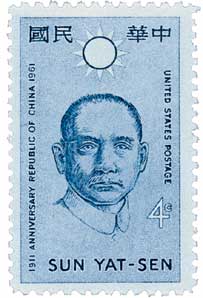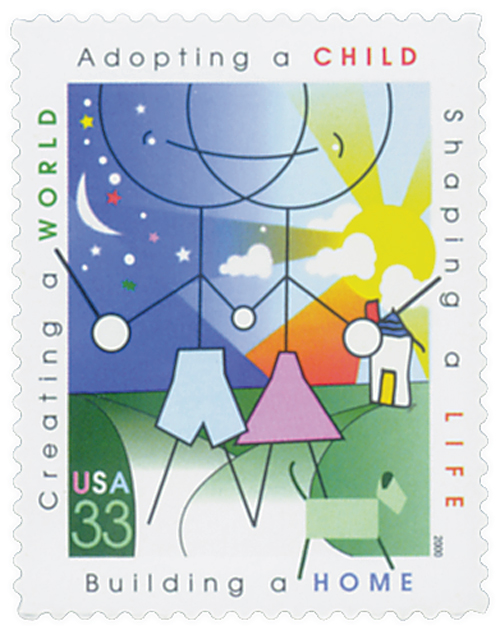
# 3398 FDC - 2000 33c Adoption
2000 33¢ Adoption
City: Beverly Hills, CA
Quantity: 200,000,000
Birth of Pearl S. Buck

Author Pearl Sydenstricker Buck was born on June 26, 1892, in Hillsboro, West Virginia. She was awarded the Pulitzer Prize in 1932, the Nobel Prize in 1938, and was the only woman at that time to receive both honors.
Buck’s parents had lived in China prior to her birth, but returned to the US so she could be born there. When she was five months old, they went back to China. Buck grew up in Huai-an, Zhenjuang, and Shanghai. She learned English, classical Chinese, and the local Chinese dialect. Buck loved to read and would later read all of Charles Dickens’s novels every year.

Buck returned to the US in 1911 to attend Randolph-Macon Woman’s College in Virginia. While she didn’t initially intend to return to China, when she received word that her mother was ill, she applied to become a Presbyterian missionary, serving from 1914 to 1932.
Pearl married John Lossing Buck in 1917 and taught English literature at a few Chinese colleges and universities. She and her husband returned to the US in 1924 for a year, during which time she earned her master’s degree from Cornell University. After returning to China, her family was displaced during the Nanking Incident of March, 1927. They spent a day in hiding before fleeing to Japan for most of the remainder of the year.

Once she returned to China in late 1927, Buck decided to become a professional writer to support herself and care for her sick daughter. Three years later, she published her first novel, East Wind: West Wind. She followed that a year later with The Good Earth. The Good Earth was the best-selling fiction novel in the US in 1931 and earned Buck the Pulitzer Prize in 1932.
On a later trip back to the US, Buck gave a speech at a Presbyterian women’s luncheon that shared her belief that missionaries to China were unnecessary. When her address was published in Harper’s Magazine, she came under heated criticism and resigned her position with the Presbyterian Board.
Buck moved back to the US permanently in 1934, and was prohibited from returning to China following the Communist Revolution. In 1938 she became the first American woman to win the Nobel Prize in Literature, “for her rich and truly epic descriptions of peasant life in China and for her biographical masterpieces.”

Buck continued to write novels and short stories for the rest of her life. Many of her works explored women’s rights, Asian culture, immigration, adoption, missionary work, war, and violence. She aided a relief campaign for victims of the 1931 China floods. In 1949, Buck helped co-found Welcome House Inc. which was the first international, interracial adoption agency. Then in 1964, she founded the Pearl S. Buck Foundation to provide aid to children who weren’t eligible for adoption. Buck also opened orphanages in South Korea, Thailand, the Philippines, and Vietnam.

Buck died of lung cancer on March 6, 1973. Buck’s birthplace was later made into a historic house and cultural center on the National Register of Historic Places. Her former home at Nanjing University was designated a memorial house.

2000 33¢ Adoption
City: Beverly Hills, CA
Quantity: 200,000,000
Birth of Pearl S. Buck

Author Pearl Sydenstricker Buck was born on June 26, 1892, in Hillsboro, West Virginia. She was awarded the Pulitzer Prize in 1932, the Nobel Prize in 1938, and was the only woman at that time to receive both honors.
Buck’s parents had lived in China prior to her birth, but returned to the US so she could be born there. When she was five months old, they went back to China. Buck grew up in Huai-an, Zhenjuang, and Shanghai. She learned English, classical Chinese, and the local Chinese dialect. Buck loved to read and would later read all of Charles Dickens’s novels every year.

Buck returned to the US in 1911 to attend Randolph-Macon Woman’s College in Virginia. While she didn’t initially intend to return to China, when she received word that her mother was ill, she applied to become a Presbyterian missionary, serving from 1914 to 1932.
Pearl married John Lossing Buck in 1917 and taught English literature at a few Chinese colleges and universities. She and her husband returned to the US in 1924 for a year, during which time she earned her master’s degree from Cornell University. After returning to China, her family was displaced during the Nanking Incident of March, 1927. They spent a day in hiding before fleeing to Japan for most of the remainder of the year.

Once she returned to China in late 1927, Buck decided to become a professional writer to support herself and care for her sick daughter. Three years later, she published her first novel, East Wind: West Wind. She followed that a year later with The Good Earth. The Good Earth was the best-selling fiction novel in the US in 1931 and earned Buck the Pulitzer Prize in 1932.
On a later trip back to the US, Buck gave a speech at a Presbyterian women’s luncheon that shared her belief that missionaries to China were unnecessary. When her address was published in Harper’s Magazine, she came under heated criticism and resigned her position with the Presbyterian Board.
Buck moved back to the US permanently in 1934, and was prohibited from returning to China following the Communist Revolution. In 1938 she became the first American woman to win the Nobel Prize in Literature, “for her rich and truly epic descriptions of peasant life in China and for her biographical masterpieces.”

Buck continued to write novels and short stories for the rest of her life. Many of her works explored women’s rights, Asian culture, immigration, adoption, missionary work, war, and violence. She aided a relief campaign for victims of the 1931 China floods. In 1949, Buck helped co-found Welcome House Inc. which was the first international, interracial adoption agency. Then in 1964, she founded the Pearl S. Buck Foundation to provide aid to children who weren’t eligible for adoption. Buck also opened orphanages in South Korea, Thailand, the Philippines, and Vietnam.

Buck died of lung cancer on March 6, 1973. Buck’s birthplace was later made into a historic house and cultural center on the National Register of Historic Places. Her former home at Nanjing University was designated a memorial house.









